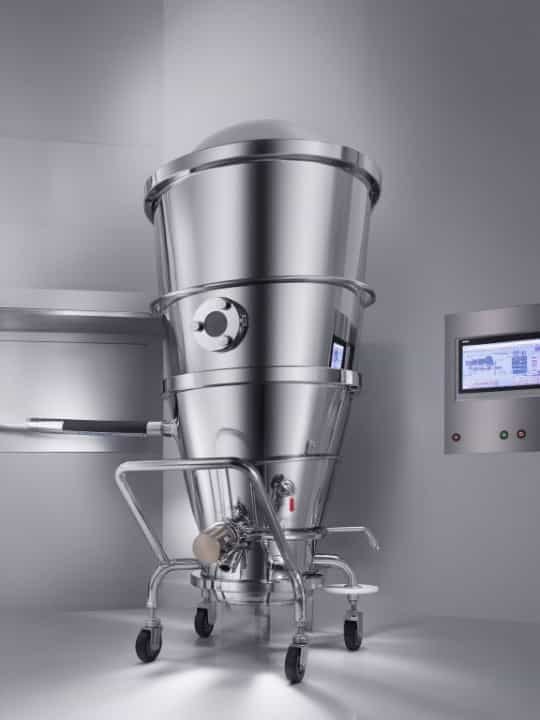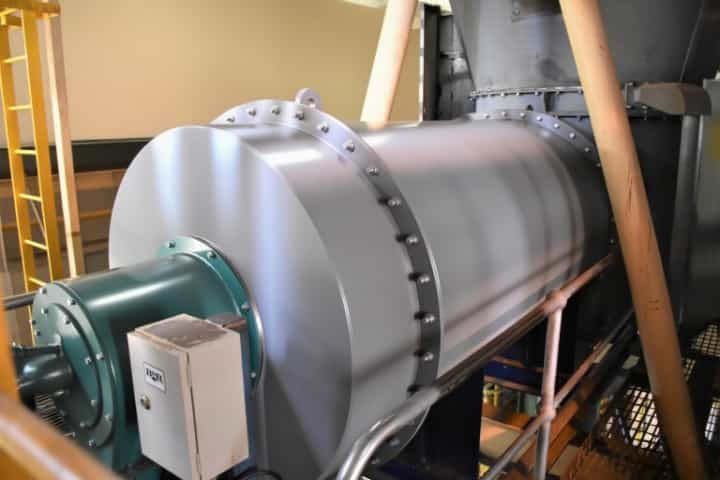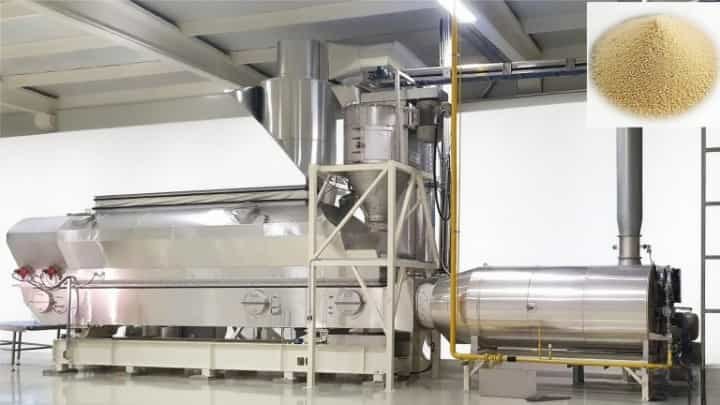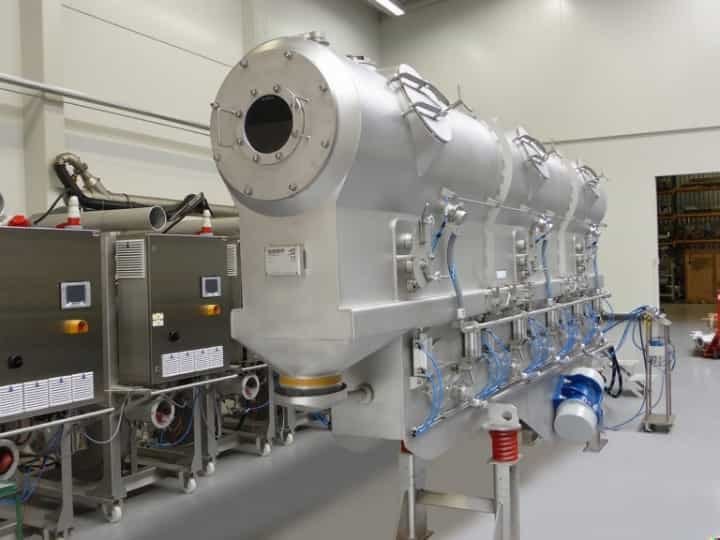A fluid bed dryer blows air to lift and mix solid pieces. This helps remove water from them more easily. Many industries use this kind of dryer today. The global market for fluid bed dryers was USD 2.5 billion in 2024. It keeps growing at a 5.3% yearly rate. In 2025, the main users are:
Food and beverage makers drying fruits, vegetables, and meals
Pharmaceutical companies for making and packing products
Chemical, cosmetics, agrochemical, and building material makers
These facts show that many people need fluid bed dryers. They are used a lot in modern factories.
Key Takeaways
Fluid bed dryers blow hot air to lift and mix particles. This dries them fast and evenly. It also keeps sensitive materials safe.
New fluid bed dryers in 2025 have automation, AI, and energy-saving designs. These features help control the process better. They also help reduce waste.
Operators must watch temperature, airflow, and moisture very closely. This keeps drying safe, efficient, and steady.
These dryers are used in many industries like food, pharmaceuticals, chemicals, and mining. They can handle both small and large batches easily.
Fluid bed dryers dry things quickly and give precise control. They need little maintenance and make high-quality products. This makes them a top choice today.
What Are the Basics of Fluid Bed Drying?
Fluid bed drying is a process where particles are fluidized in a stream of air, causing moisture to evaporate. This method ensures uniform drying, high efficiency, and is commonly used in pharmaceuticals, food, and chemical industries.
What Is a Fluid Bed Dryer?
A fluid bed dryer is a machine that dries solid materials. It uses hot air or gas to blow through a bed of particles. The air lifts and mixes the particles. This makes them move like a liquid. This is called fluidization. When the particles move around, the hot air touches all sides. This helps them dry faster and more evenly.
Many factories use a fluidized bed dryer because it works with many materials. It is used in food, chemical, and pharmaceutical industries. The machine is good for drying powders, granules, and small pieces. It can dry things that are sensitive to heat. This helps keep their quality high.
There are two main types of fluidized bed dryers in 2025:
Vibratory fluid bed dryers: These use shaking to move the particles and help drying.
Fluid bed granulation systems: These can dry, mix, granulate, and cool at the same time. They are important for making medicines and other products that need special care.
A fluidized bed dryer is better than some old machines, like rotary dryers, when you need gentle handling and even drying.
Key Features in 2025
In 2025, fluidized bed dryer technology is much better. Companies want machines that save energy, work fast, and are easy to use. Some new features are:
Increased automation: New fluid bed dryers use computers to control drying. This means workers do not have to change things by hand. Automation keeps the process steady and safe.
AI and IoT integration: Many new dryers use artificial intelligence (AI) and the Internet of Things (IoT). These tools help the machine watch itself and make smart choices. Sensors check temperature and moisture all the time. The system can change settings to get the best drying.
Energy-efficient designs: New fluidized bed dryers use less energy than old ones. They have better insulation and smarter air flow. Some machines reuse exhaust air, but this works best if dust collection systems are used to stop problems.
Focus on sustainability: Companies care more about the environment now. They use eco-friendly materials and try to make less waste. New designs help meet strict rules about pollution and energy use.
Note: Fluidized bed dryers in 2025 give better control, dry faster, and save more energy. But the real energy savings depend on the material and how the machine is used.
Here is a table that shows facts about energy use and automation in fluid bed dryers in 2025:
Aspect | Common Misconception | Reality in 2025 |
|---|---|---|
Electricity Usage | Fluid bed dryers are more energy efficient overall | Fluid bed dryers use up to 20% more electricity because they need lots of air |
Fuel Consumption | Fluid bed dryers use less fuel than rotary dryers | Fuel use is about the same; rotary dryers use higher heat to balance efficiency |
Evaporative Cooling Savings | Up to 10% energy savings claimed | Real savings are closer to 2% on average |
Use of Recycled Exhaust Air | Recycling always saves energy | Works best with dust collection to stop duct problems |
Particle Size Variation | Not a big concern | Changes in particle size can lower efficiency; best with same-size particles |
Fluidized bed dryers are still very important in many industries. They give even drying, gentle handling, and advanced control. This makes them a top choice for drying powders and granules in 2025.
What Is the Fluidized Bed Drying Process?
The fluidized bed drying process involves suspending solid particles in an upward flow of gas, creating a fluid-like state for efficient moisture removal. This method ensures uniform drying and high heat transfer rates.

Principle of Fluidization
Fluidized bed drying starts with a simple idea. Air moves up through solid particles in the dryer. When the air goes fast, it lifts the particles. The particles float and mix together. This makes them act like a liquid. The air touches every part of each particle. This helps control heat and wetness around them.
Some things change how fluidization works:
Particle size and shape
Height of the bed
Wetness of the air coming in
When the air pushes as much as the particles weigh, the bed becomes fluidized. The particles do not stick to each other. This helps the drying work well. The dryer uses this way to keep heat and wetness the same everywhere. This makes sure all particles lose water at the same speed.
Tip: The right airflow and heat stop clumps and uneven drying. Workers should check wetness and moisture often.
Drying Mechanism
The way fluidized bed drying works is special. The dryer blows hot air under a plate with holes. This air lifts the material and makes it move like a liquid. Hot air covers each particle and dries it fast and evenly. The heat stays the same, so burning or overheating is less likely.
Fluidized bed drying dries things quickly because air and particles mix well. The system can change heat and wetness for each product. Shaking can break up lumps and keep soft particles moving. The dryer can have different zones with different heat to cool and steady the material. This stops water from coming back and keeps things dry.
Belt dryers can leave some parts wet and others dry. Fluidized bed drying gives even results. The process keeps heat and wetness steady, so the end product has the right amount of water. This way works well for powders, granules, and other small pieces that need careful drying.
Parameter | Effect on Drying |
|---|---|
Airflow Rate | Controls fluidization and moisture removal |
Temperature | Affects drying speed and product safety |
Humidity | Impacts final moisture content |
Particle Size | Changes fluidization and drying efficiency |
Fluidized bed drying is great at managing heat, wetness, and moisture. This makes drying safe, fast, and even for many products.
What Are the Main Components of a Fluidized Bed Dryer?
A fluidized bed dryer primarily consists of a drying chamber, an air distribution system, a heating unit, a material feeding system, and a control panel. These components work in unison to efficiently dry bulk materials.

Air Distribution
A fluidized bed dryer has a special system to spread air. The air handling unit gets the air ready and cleans it. The air goes through a plate with holes at the bottom. This plate helps the air reach all the particles. Every particle gets the same heat. Some plates can make the air swirl. Swirling air helps dry things faster and saves energy.
A blower pushes the air at the right speed. Good air flow keeps the chamber temperature steady. Workers use tools to check air and heat in many spots. If air is too slow, particles do not float well. If air is too fast, some material can be lost. Checking the air system keeps drying safe and works well.
Tip: Spreading air well and checking often stops clumps and uneven drying.
Product Chamber
The product chamber is where the drying happens. It is made from stainless steel to handle heat and pressure. Inside, there is a bowl you can take out. The bowl has holes at the bottom. Hot air comes from below and moves through the holes. This makes the granules float and dry.
Good air plates and the right pressure drop keep things stable. The chamber is easy to clean and lets you remove dried stuff fast. Checking the heat inside is important for good quality. Workers use sensors to watch heat and wetness all the time. This keeps drying safe and in control.
Stainless steel makes it strong
Removable bowl is easy to clean
Holes at the bottom help air flow
Sensors check heat and wetness
Heating and Controls
The heating system gives energy to dry things. It uses steam or electric heaters to warm the air. The system changes the heat for each product. Checking heat in many places keeps things safe and works well.
A control panel lets workers set heat, air, and time. New dryers have smart systems to watch everything. These systems check heat, wetness, fan speed, and feed rates. Workers use this info to make quick changes. The control system helps save energy by changing settings when needed.
Heaters control heat exactly
Control panel makes changes easy
Systems watch heat, wetness, and air
Alarms warn if something is wrong
Note: Watching heat and other things all the time helps save energy and keeps the product good.
What Are the Steps Involved in Dryer Operation?
Operating a dryer involves several key steps to ensure efficient performance and safety. First, sort your laundry by fabric type and weight. Next, clean the lint filter to prevent fire hazards. Load the dryer without overfilling it, allowing enough space for clothes to tumble. Select the appropriate drying cycle and temperature setting based on your laundry type. Start the dryer and monitor progress, removing clothes promptly once dry to avoid wrinkles.

Loading and Start-Up
Operators put the material into the dryer chamber. They check how wet the material is at the start. The material must spread out evenly in the chamber. This helps air touch every piece during drying. The operator sets the heat and airflow using the control panel. Sensors start checking heat, humidity, and wetness right away. In lab dryers, workers use small amounts and watch closely. Big dryers handle more material and use better monitoring tools.
Batch dryers dry one load at a time. Workers fill the chamber, set the heat, and begin the cycle. Continuous dryers work another way. Material goes in one side and moves on a shaking belt. The system keeps checking heat, humidity, and wetness as new material enters. This design lets the dryer work all the time with big loads.
Drying Cycle
The drying cycle starts when hot air moves through the chamber. The air goes through a plate with holes and lifts the particles. This makes the particles mix and float. Every piece gets to touch the hot air. The heat stays the same, and sensors keep checking the process. Operators watch wetness, heat, and humidity at different spots.
Load and spread the material
Blow in hot air and set the heat
Make the particles float and mix
Keep checking wetness, heat, and humidity
Remove water and filter the air
Batch dryers finish drying before workers take out the load. Continuous dryers move material through zones with different heat and humidity. This setup lets workers watch and change things as needed.
Aspect | Batch Fluid Bed Dryer | Continuous Fluid Bed Dryer |
|---|---|---|
Stays still during drying | Moves through the dryer | |
Monitoring | Manual or partly automatic | Very automatic, checks all the time |
Temperature Control | Set for each load | Changed in many zones |
Moisture Content Check | Checked at the end | Checked often at many spots |
Discharge and Cleaning
After drying, operators check if the material is dry enough. In batch dryers, they open the chamber and take out the dried load. Continuous dryers let material out with gates or belts. Sensors keep checking to make sure the dryness is right.
Cleaning is needed for both types. Operators take out leftover pieces and look for buildup. They watch heat and humidity during cleaning to avoid problems. Lab dryers clean fast, but big dryers may use machines to clean. Good cleaning keeps the dryer working well and helps sensors give correct readings next time.
Tip: Checking things often during loading, drying, and cleaning keeps the product good and the dryer working well.
Where Is Dryer Operation Used and How Well Does It Perform?
Dryer operations are primarily used in industrial, commercial, and residential settings to remove moisture from various materials. In industrial contexts, they are critical for processes in sectors like food processing, pharmaceuticals, and textiles.

Pharmaceutical Granules and Powders
Fluid bed dryers are very important in making medicine. They dry pharmaceutical granules and powders with a lot of care. These machines watch the moisture content very closely. This helps keep tablets, capsules, and other medicines high quality. The drying uses hot air to lift and mix the particles. This way, every piece gets the right amount of moisture.
Pharmaceutical companies pick fluid bed dryers because they handle things gently. The dryers stop damage to sensitive ingredients. Operators can set the temperature for each product. This helps stop overheating or burning. The dryers also dry things quickly, which saves time and energy.
Many companies use these dryers for both small and big jobs. They can dry small test batches or large amounts for big factories. The dryers keep the moisture even in all pharmaceutical granules. This even drying is important for safe and good medicine.
Tip: Watching temperature and airflow carefully helps keep the moisture just right for each batch of pharmaceutical granules.
Other Industry Uses
Fluid bed dryers are used in many industries, not just medicine. Each industry uses these machines for different drying jobs. The table below shows some main uses:
Industry | Primary Applications |
|---|---|
Pharmaceutical | Drying drug formulations such as tablets, capsules, and powders with precise moisture control and quality requirements. |
Chemical | Drying chemical compounds, catalysts, and specialty materials to ensure consistent quality and safety. |
Food Processing | Drying spices, herbs, dairy products, and powdered foods to preserve nutritional value and extend shelf life. |
Mining & Minerals | Drying mineral concentrates, ores, and industrial minerals to improve transportability and processing. |
Other Industries | Includes agriculture, energy, and construction sectors utilizing fluid bed dryers for various drying needs. |
In food factories, fluid bed dryers dry spices, herbs, and dairy powders. They keep moisture low to stop food from spoiling and keep it safe. The dryers also help make powdered foods last longer. In chemical plants, these dryers dry compounds and catalysts. They keep the moisture steady for safe storage and use.
Mining companies use fluid bed dryers to dry mineral concentrates and ores. This makes the materials easier to move and work with. Other industries, like farming and building, use these dryers for seeds, fertilizers, and building materials.
Fluid bed dryers in food and chemical plants can handle many sizes of jobs. Some machines dry a few hundred pounds each hour. Others can dry up to 30-40 tons every hour. The size and power depend on the product’s moisture, how much material there is, air temperature, and airflow. Dryer sizes go from small lab units to big machines with up to 162 square feet per unit.
Advantages and Disadvantages
Fluid bed dryers have many good points over other dryers. They dry things fast and evenly by blowing hot air around the particles. This makes sure every piece gets the right moisture quickly. The dryers are good for products that do not like too much heat. Operators can control the temperature and airflow to stop damage.
Some main benefits are:
Fast and even drying for powders, granules, and small pieces.
Exact control of temperature and moisture, which protects sensitive products.
High efficiency, with thermal efficiency up to three times better than old dryers.
Easy to use and less work needed, with some models easy to move.
Many sizes and powers for different jobs.
Low maintenance costs because of strong stainless steel parts.
No hot spots, so products do not get ruined.
Good for both batch and continuous drying without big changes.
Fluid bed dryers also use less energy because of their smart design. They can be changed for special products. Advanced controls help operators run the drying and keep the moisture right. Safety features help stop fires and explosions. Special coatings inside stop product from sticking.
Note: Fluid bed dryers give high product quality, save energy, and keep workers safe. They work well for many materials and industries.
Some things can change how well a fluid bed dryer works. The size and shape of the particles matter. If the particles are too big or too small, drying may not be even. The material must work well with the fluidization process. Some products may break if they are too weak. Operators must check the moisture often to make sure the drying is done.
Fluid bed dryers are still a top choice for industries that need careful control of moisture, temperature, and drying speed. Their ability to give even drying and high efficiency makes them important in 2025 and later.
Fluid bed dryers are used in many industries to dry things quickly and evenly. They help make sure products are good quality. When picking a dryer, people should:
Look at how long it takes to dry, if the drying is even, and if the dryer can work with different things.
Make sure the dryer is right for their type of work and product.
Rules say workers must watch the dryer closely to keep things safe and get the same results every time.
Some new changes are smarter controls and saving more energy. People should think about what they need and talk to experts before they buy a dryer.
FAQ
How does monitoring improve fluid bed dryer performance?
Monitoring lets workers watch temperature, airflow, and moisture all the time. This helps the dryer work well. Workers can quickly fix things to keep drying safe and even.
What tools do operators use for monitoring in 2025?
Workers use sensors and smart systems to check the dryer. These tools watch heat, humidity, and airflow. Some dryers link to computers or phones. This lets workers see and control the dryer from anywhere.
Why is monitoring important for product quality?
Monitoring keeps drying steady. It stops things from getting too hot or too wet. When workers watch closely, they keep the product safe and good. Good monitoring also means less waste.
Can monitoring lower energy use in fluid bed dryers?
Yes. Monitoring helps workers use less energy. When the system finds the right heat and airflow, it does not waste energy. This saves money and helps the planet.
How often should operators perform monitoring during drying?
Workers should check the dryer during the whole drying time. Checking often helps find problems early. Watching all the time gives the best results for small and big batches.

